Finding Tilly - Educational Kid-Friendly Web Game
🎮 Introduction: Why I Chose This Game
For the AWS Build Games with Amazon Q CLI Challenge, I wanted to create a game that was not only fun to build — but meaningful in purpose. With AI as my co-creator, I set out to design something that combined entertainment with educational value. That’s how "Finding Tilly" was born.
It's a kid-friendly adventure game that helps young children build foundational skills like alphabet recognition, number sequencing, and basic addition — all wrapped in a visually engaging, story-driven experience.
💡 Why This Concept?
I chose this idea for several key reasons:
- 🎯 It addresses a real need: making learning genuinely fun for kids
- 🧠 It has a simple, engaging premise that’s easy for young minds to follow
- 📚 It naturally integrates multiple layers of educational content
- 👀 Its visual design makes it accessible even to pre-readers
- 🌱 It's modular and scalable — the game evolves as the child grows
Thanks to Amazon Q CLI, building this experience was fast, flexible, and AI-assisted from start to finish. It allowed me to focus on creativity while automating much of the setup and development process.
"Finding Tilly" is more than just a submission — it’s a small step toward using AI to inspire learning through play.
The Development Journey
Day 1: From Concept to Initial Implementation
Our journey began with a simple text-based Python implementation:
#!/usr/bin/env python3
"""
Finding Tilly - A simple adventure game for kids
"""
import random
import time
import os
def clear_screen():
"""Clear the terminal screen."""
os.system('cls' if os.name == 'nt' else 'clear')
class Game:
def __init__(self):
self.player_name = ""
self.tilly_location = ""
self.current_location = "home"
# More initialization code...
This initial version featured:
- Location-based navigation
- Item collection
- A hint system
- Random placement of Tilly
However, I quickly realized that a text-based interface wouldn't be suitable for very young children who might not be able to read or type commands.
Day 2: Pivoting to a Web-Based Approach
The next iteration transformed the game into a web application with a kid-friendly UI:
<div id="game-container">
<div id="welcome-screen" class="screen">
<h1>Finding Tilly</h1>
<p>Oh no! Tilly is hiding somewhere!</p>
<!-- More welcome screen content -->
</div>
<div id="game-screen" class="screen hidden">
<!-- Game content -->
</div>
</div>
Day 3: Educational Transformation
The most significant pivot came when I decided to enhance the educational value by integrating puzzles:
// Educational puzzles by category
puzzles: {
alphabet: [
{ question: "What letter comes after A?", answer: "B", options: ["B", "C", "D"] },
// More alphabet puzzles
],
numbers: [
{ question: "What number comes after 5?", answer: "6", options: ["6", "7", "8"] },
// More number puzzles
],
addition: [
{ question: "What is 2 + 3?", answer: "5", options: ["4", "5", "6"] },
// More addition puzzles
]
}
Effective Prompting Techniques I Discovered
Working with AI to develop this game taught me several valuable prompting techniques:
1. Start with a Clear Vision, But Be Flexible
My initial prompt outlined the basic game concept, but I remained open to AI suggestions and improvements:
"I would like to create a game for my kid. help me get started with it"
This open-ended approach allowed the AI to suggest a text-based game first, which we later refined into a web application.
2. Iterative Refinement Through Conversation
Rather than trying to get everything perfect in one prompt, I used an iterative approach:
"I would like to keep the concept as is but would like to change the way we find tilly in the game. I would like this game to serve as an educational tool to help my kid learn alphabets, numbers, basic addition up to number 20, find missing number in sequence, find missing alphabet in a sequence"
This conversational style allowed us to build on previous work while making significant changes to the game mechanics.
3. Providing Specific Requirements for Targeted Solutions
When I needed specific functionality, I clearly articulated the requirements:
"update the blog post to cover the following areas - Your chosen game and why you picked it
- Effective prompting techniques you discovered
- How AI handled classic programming challenges
- Examples of development automation that saved you time
- Code examples of interesting AI-generated solutions
- Screenshots or gameplay footage of your final creation"
4. Letting the AI Handle Implementation Details
For technical implementation, I focused on the "what" rather than the "how," allowing the AI to determine the best approach:
"I would like to create a web application for this game. UI should be kid friendly."
How AI Handled Classic Programming Challenges
Throughout development, the AI demonstrated impressive capabilities in addressing common programming challenges:
1. State Management
The AI created a clean state management system for the game without being explicitly asked to do so:
// Game state
const gameState = {
playerName: "",
currentLocation: "home",
tillyLocation: "",
inventory: [],
hintsUsed: 0,
moves: 0,
gameStarted: false,
gameWon: false,
currentPuzzle: null,
puzzlesSolved: 0,
// Educational puzzles by category
puzzles: {
// Puzzle definitions
},
// Game locations and their properties
locations: {
// Location definitions
}
};
This approach encapsulated all game data in a single object, making it easier to track and modify.
2. Event Handling
The AI implemented a robust event handling system for user interactions:
// Initialize the game
function initGame() {
// Event listeners
startButton.addEventListener('click', startGame);
hintButton.addEventListener('click', getHint);
lookButton.addEventListener('click', lookAround);
playAgainButton.addEventListener('click', resetGame);
// Allow pressing Enter to start the game
playerNameInput.addEventListener('keypress', function(e) {
if (e.key === 'Enter') {
startGame();
}
});
// Preload images
preloadImages();
}
3. Dynamic Content Generation
The AI created functions to dynamically generate game elements based on the current state:
// Update puzzle display
function updatePuzzleDisplay(puzzleType) {
// Get a random puzzle of the specified type
const puzzles = gameState.puzzles[puzzleType];
const randomPuzzle = puzzles[Math.floor(Math.random() * puzzles.length)];
gameState.currentPuzzle = randomPuzzle;
// Update puzzle question
puzzleQuestion.textContent = randomPuzzle.question;
// Update puzzle options
puzzleOptions.innerHTML = '';
// Shuffle options for variety
const shuffledOptions = [...randomPuzzle.options].sort(() => Math.random() - 0.5);
shuffledOptions.forEach(option => {
const button = document.createElement('button');
button.className = 'puzzle-option';
button.textContent = option;
button.addEventListener('click', () => checkAnswer(option));
puzzleOptions.appendChild(button);
});
}
4. Responsive Design
The AI implemented a responsive design that works across different screen sizes:
@media (min-width: 768px) {
#game-area {
flex-direction: row;
}
}
#location-image-container {
flex: 1;
text-align: center;
}
#game-info {
flex: 1;
display: flex;
flex-direction: column;
gap: 15px;
}
Development Automation That Saved Time
Working with AI dramatically accelerated the development process in several ways:
1. Rapid Prototyping
The AI generated a complete, functional prototype in minutes rather than hours or days. This included:
- HTML structure
- CSS styling
- JavaScript game logic
- Directory structure
2. Code Refactoring
When pivoting from a collection-based game to an educational puzzle game, the AI handled the refactoring process seamlessly:
// Before: Item collection mechanic
function takeItem(item) {
gameState.inventory.push(item);
const locationItems = gameState.locations[gameState.currentLocation].items;
const itemIndex = locationItems.indexOf(item);
if (itemIndex > -1) {
locationItems.splice(itemIndex, 1);
}
// Update UI...
}
// After: Educational puzzle mechanic
function checkAnswer(selectedAnswer) {
gameState.moves++;
if (selectedAnswer === gameState.currentPuzzle.answer) {
gameState.puzzlesSolved++;
showMessage("That's correct! Great job!");
if (gameState.puzzlesSolved >= 5) {
findTilly();
} else {
const location = gameState.locations[gameState.currentLocation];
updatePuzzleDisplay(location.puzzleType);
}
} else {
showMessage("That's not quite right. Try again!");
}
}
3. Documentation Generation
The AI automatically generated comprehensive documentation, including:
- README.md with game instructions
- Development blog tracking our progress
- Code comments explaining functionality
4. Project Structure Organization
The AI created a logical project structure with appropriate directories:
/finding_tilly
├── index.html
├── styles.css
├── game.js
├── README.md
├── finding_tilly_game.md
├── /images
└── /sounds
Interesting AI-Generated Solutions
Several solutions generated by the AI were particularly clever or elegant:
1. Puzzle Randomization with Answer Validation
// Update the puzzle display
function updatePuzzleDisplay(puzzleType) {
// Get a random puzzle of the specified type
const puzzles = gameState.puzzles[puzzleType];
const randomPuzzle = puzzles[Math.floor(Math.random() * puzzles.length)];
gameState.currentPuzzle = randomPuzzle;
// Update puzzle question
puzzleQuestion.textContent = randomPuzzle.question;
// Update puzzle options
puzzleOptions.innerHTML = '';
// Shuffle options for variety
const shuffledOptions = [...randomPuzzle.options].sort(() => Math.random() - 0.5);
shuffledOptions.forEach(option => {
const button = document.createElement('button');
button.className = 'puzzle-option';
button.textContent = option;
button.addEventListener('click', () => checkAnswer(option));
puzzleOptions.appendChild(button);
});
}
This solution not only selects random puzzles but also shuffles the answer options each time, preventing children from memorizing positions rather than learning the content.
2. Context-Aware Hint System
// Get a hint
function getHint() {
// Play sound effect
try {
soundEffects.hint.play();
} catch (e) {
console.log('Sound could not be played');
}
gameState.hintsUsed++;
gameState.moves++;
// Update moves counter
movesCounter.textContent = `Moves: ${gameState.moves}`;
// Give a hint for the current puzzle
const puzzle = gameState.currentPuzzle;
let hintMessage = "";
if (puzzle.question.includes("letter")) {
hintMessage = `Think about the alphabet: A, B, C, D, E, F...`;
} else if (puzzle.question.includes("number")) {
hintMessage = `Count carefully: 1, 2, 3, 4, 5...`;
} else if (puzzle.question.includes("+")) {
hintMessage = `Try counting on your fingers!`;
}
showMessage(`Hint: ${hintMessage}`);
}
This hint system analyzes the current puzzle type and provides appropriate guidance without giving away the answer directly.
3. Educational Location Descriptions
// Look around the current location
function lookAround() {
gameState.moves++;
// Update moves counter
movesCounter.textContent = `Moves: ${gameState.moves}`;
// Show a more detailed description
const location = gameState.locations[gameState.currentLocation];
let message = `You look carefully around the ${formatLocationName(gameState.currentLocation)}. `;
// Add some random details based on the location
const details = {
"home": ["You notice some alphabet blocks on the floor.", "There's a counting chart on the wall.", "You see some math flashcards on the table."],
"garden": ["The flowers are arranged in numbered rows.", "There are alphabet stones in the garden path.", "You see numbers painted on the garden gnomes."],
// More location details...
};
// Add a random detail
const locationDetails = details[gameState.currentLocation];
if (locationDetails) {
message += locationDetails[Math.floor(Math.random() * locationDetails.length)];
}
// Add hint about puzzles
message += " Solving puzzles will help you find Tilly!";
showMessage(message);
}
This function creates immersive, educational descriptions that reinforce learning concepts while maintaining the game's narrative.
Final Game: Screenshots and Gameplay
Note: To complete the game, you'll need to add images to the /images folder and sound files to the /sounds folder.
When complete, the game will feature:
- A welcoming start screen where children enter their name
- Colorful location images with educational puzzles
- Multiple-choice answers with immediate feedback
- A celebration screen when Tilly is found
The gameplay loop involves:
- Navigating between locations
- Solving educational puzzles (alphabet, numbers, addition)
- Using hints when needed
- Finding Tilly after solving 5 puzzles
Conclusion: The Power of AI-Assisted Game Development
Creating "Finding Tilly" with AI assistance demonstrated how powerful this approach can be for educational game development. The process was:
- Efficient: What might have taken weeks was accomplished in hours
- Iterative: We could quickly pivot and refine the concept
- Creative: The AI suggested features and approaches I might not have considered
- Educational: The final product balances fun gameplay with valuable learning
For parents or educators looking to create custom educational content, AI-assisted development offers an accessible path to creating engaging, personalized learning experiences without requiring extensive programming knowledge.
The "Finding Tilly" game now stands ready to help children learn fundamental skills while having fun on an adventure - a perfect example of how AI can help create meaningful educational experiences.
This development blog documents the creation of "Finding Tilly," an educational game developed with AI assistance.
Day 5: Converting to a React Single-Page Application with Firebase Backend
Why React and Firebase?
After successfully creating our educational web game with vanilla JavaScript, we decided to take "Finding Tilly" to the next level by converting it to a React single-page application (SPA) with a Firebase backend. This decision was driven by several factors:
- Better State Management: React's component-based architecture and state management would make the game more maintainable
- Progress Tracking: We wanted to save user progress and questions in a database
- Leaderboard Feature: To motivate continued learning through friendly competition
- Scalability: The ability to easily add more features and puzzles over time
Firebase was chosen as our backend solution because:
- It offers a real-time database perfect for tracking progress
- Authentication is built-in and easy to implement
- It's serverless, reducing maintenance overhead
- The free tier is generous for our needs
- Offline support ensures the game works even with intermittent internet
Implementation Process
1. Setting Up the React Project
We started by creating a new React application and installing the necessary dependencies:
npx create-react-app finding-tilly-react
cd finding-tilly-react
npm install firebase react-router-dom
2. Project Structure
We organized our project with a clear component structure:
src/
├── components/
│ ├── WelcomeScreen.js
│ ├── GameScreen.js
│ ├── LocationDisplay.js
│ ├── PuzzleDisplay.js
│ ├── Navigation.js
│ ├── WinScreen.js
│ └── LeaderboardScreen.js
├── contexts/
│ ├── GameContext.js
│ └── AuthContext.js
├── services/
│ ├── firebase.js
│ └── gameService.js
├── styles/
│ ├── WelcomeScreen.css
│ ├── GameScreen.css
│ └── ...
└── assets/
├── images/
└── sounds/
3. Context-Based State Management
One of the most significant improvements was implementing context-based state management:
// GameContext.js
const GameContext = createContext();
export const GameProvider = ({ children }) => {
const [gameState, setGameState] = useState({
playerName: "",
userId: null,
currentLocation: "home",
currentPuzzle: null,
puzzlesSolved: 0,
hintsUsed: 0,
moves: 0,
gameStarted: false,
gameWon: false,
// More state...
});
// Methods for updating state...
return (
<GameContext.Provider value={{ gameState, updateGameState, resetGame, formatLocationName, playSound }}>
{children}
</GameContext.Provider>
);
};
This approach allowed us to:
- Share game state across all components
- Centralize game logic
- Easily persist state between route changes
4. Firebase Integration
We integrated Firebase for authentication and data storage:
// Firebase configuration
import { initializeApp } from "firebase/app";
import { getFirestore } from "firebase/firestore";
import { getAuth } from "firebase/auth";
const firebaseConfig = {
// Configuration details
};
const app = initializeApp(firebaseConfig);
const db = getFirestore(app);
const auth = getAuth(app);
We created services to interact with Firebase:
// Fetch puzzles by type and difficulty
export const fetchPuzzles = async (type, difficulty = 'easy', count = 5) => {
try {
const puzzlesRef = collection(db, 'puzzles');
const q = query(
puzzlesRef,
where('type', '==', type),
where('difficulty', '==', difficulty),
limit(count)
);
const querySnapshot = await getDocs(q);
const puzzles = [];
querySnapshot.forEach((doc) => {
puzzles.push({ id: doc.id, ...doc.data() });
});
return puzzles;
} catch (error) {
console.error("Error fetching puzzles:", error);
return [];
}
};
5. User Authentication
We implemented a flexible authentication system that supports both registered users and guest mode:
// Create or update guest user
const createGuestUser = async (name) => {
try {
// Generate a unique ID for the guest user
const guestId = `guest_${Date.now()}`;
// Create user document in Firestore
await setDoc(doc(db, 'users', guestId), {
name: name,
isGuest: true,
createdAt: new Date(),
progress: {
totalPuzzlesSolved: 0,
alphabetPuzzlesSolved: 0,
numberPuzzlesSolved: 0,
additionPuzzlesSolved: 0,
hintsUsed: 0,
lastPlayed: new Date()
},
badges: []
});
// Set the guest user in state
const guestUser = {
uid: guestId,
displayName: name,
isGuest: true
};
setCurrentUser(guestUser);
return guestUser;
} catch (error) {
throw error;
}
};
This allows children to play without requiring account creation while still tracking their progress.
6. Component-Based UI
We broke down the UI into reusable components:
// PuzzleDisplay.js
const PuzzleDisplay = () => {
const { gameState, updateGameState, playSound } = useGameContext();
const [selectedAnswer, setSelectedAnswer] = useState(null);
const [feedback, setFeedback] = useState(null);
// Component logic...
return (
<div className="puzzle-container">
<h3>Puzzle</h3>
<div className="puzzle-question">{gameState.currentPuzzle.question}</div>
<div className="puzzle-options">
{shuffledOptions.map((option, index) => (
<button
key={index}
className={`puzzle-option ${selectedAnswer === option ?
(option === gameState.currentPuzzle.answer ? 'correct' : 'incorrect') : ''}`}
onClick={() => !selectedAnswer && checkAnswer(option)}
disabled={selectedAnswer !== null}
>
{option}
</button>
))}
</div>
{feedback && (
<div className={`feedback ${feedback.correct ? 'correct-feedback' : 'incorrect-feedback'}`}>
{feedback.message}
</div>
)}
</div>
);
};
7. Progress Tracking and Gamification
We implemented a badge system to motivate continued learning:
// Calculate badges based on progress
const calculateBadges = (progress) => {
const badges = [];
// Alphabet badges
if (progress.alphabetPuzzlesSolved >= 5) {
badges.push({
type: 'alphabet',
level: 'bronze',
name: 'Alphabet Explorer',
icon: '🔤'
});
}
if (progress.alphabetPuzzlesSolved >= 15) {
badges.push({
type: 'alphabet',
level: 'silver',
name: 'Alphabet Master',
icon: '📝'
});
}
// More badge calculations...
return badges;
};
8. Leaderboard Implementation
We created a leaderboard to foster friendly competition:
// Fetch leaderboard data
export const fetchLeaderboard = async (limit = 10) => {
try {
const usersRef = collection(db, 'users');
const q = query(
usersRef,
orderBy('progress.totalPuzzlesSolved', 'desc'),
limit(limit)
);
const querySnapshot = await getDocs(q);
const leaderboard = [];
querySnapshot.forEach((doc) => {
const userData = doc.data();
leaderboard.push({
id: doc.id,
name: userData.name,
puzzlesSolved: userData.progress.totalPuzzlesSolved || 0,
badges: userData.badges || []
});
});
return leaderboard;
} catch (error) {
console.error("Error fetching leaderboard:", error);
return [];
}
};
Challenges and Solutions
1. Challenge: Managing Complex State Across Components
Solution: We implemented React Context API to create a centralized state management system that all components could access.
2. Challenge: Handling Authentication for Young Users
Solution: Created a guest mode that doesn't require email/password but still tracks progress.
3. Challenge: Ensuring Offline Functionality
Solution: Implemented local fallback puzzles when Firebase connection isn't available:
// Fallback to local puzzles if Firebase fetch fails
const localPuzzles = {
alphabet: [
{ question: "What letter comes after A?", answer: "B", options: ["B", "C", "D"] },
// More puzzles...
],
// Other puzzle types...
};
4. Challenge: Providing Immediate Feedback
Solution: Added visual and audio feedback for correct/incorrect answers with CSS animations:
.puzzle-option.correct {
background-color: #4CAF50;
animation: pulse 0.5s;
}
.puzzle-option.incorrect {
background-color: #F44336;
animation: shake 0.5s;
}
@keyframes shake {
0%, 100% { transform: translateX(0); }
10%, 30%, 50%, 70%, 90% { transform: translateX(-5px); }
20%, 40%, 60%, 80% { transform: translateX(5px); }
}
Technical Improvements Over the Original Version
- Component Reusability: Breaking the UI into components makes the code more maintainable
- Declarative Routing: Using React Router for navigation between screens
- Persistent State: User progress is saved to Firebase
- Responsive Design: Improved mobile responsiveness with flexbox layouts
- Animation Effects: Added animations for better user feedback
- Offline Support: Game works even when internet connection is lost
Next Steps
With our React SPA framework in place, our next steps include:
- Firebase Deployment: Deploy the application to Firebase Hosting
- User Testing: Get feedback from children using the application
- Expanded Puzzle Library: Add more educational puzzles to the database
- Difficulty Progression: Implement adaptive difficulty based on user performance
- Parent Dashboard: Create a dashboard for parents to monitor their child's progress
- Accessibility Improvements: Ensure the game is accessible to children with different abilities
This development blog will continue to be updated as we further enhance "Finding Tilly" with additional features and refinements.
Day 6: Enhancing the Educational Experience
After successfully converting our game to a React single-page application with Firebase backend, we focused on enhancing the educational experience for young children. Our goal was to make the game more engaging, provide better visual aids, and create a more rewarding experience.
Visual Learning Aids
One of the most significant improvements was the addition of visual learning aids for different puzzle types:
// Generate visual aid based on puzzle type
const renderVisualAid = () => {
if (!gameState.currentPuzzle) return null;
const puzzle = gameState.currentPuzzle;
if (visualAidType === 'alphabet') {
// Alphabet visual aid - show alphabet sequence
return (
<div className="visual-aid alphabet-aid">
<div className="alphabet-sequence">
{Array.from('ABCDEFGHIJKLMNOPQRSTUVWXYZ').map((letter, index) => (
<span key={index} className="letter">{letter}</span>
))}
</div>
</div>
);
} else if (visualAidType === 'numbers') {
// Number visual aid - show number sequence
return (
<div className="visual-aid number-aid">
<div className="number-sequence">
{Array.from({length: 20}, (_, i) => i + 1).map((num) => (
<span key={num} className="number">{num}</span>
))}
</div>
</div>
);
} else if (visualAidType === 'addition') {
// Addition visual aid - show counting objects
// Extract numbers from the question (e.g., "What is 2 + 3?")
const numbers = puzzle.question.match(/\d+/g);
if (numbers && numbers.length >= 2) {
const num1 = parseInt(numbers[0]);
const num2 = parseInt(numbers[1]);
return (
<div className="visual-aid addition-aid">
<div className="addition-objects">
<div className="object-group">
{Array.from({length: num1}, (_, i) => (
<span key={`a${i}`} className="object">🍎</span>
))}
</div>
<span className="plus-sign">+</span>
<div className="object-group">
{Array.from({length: num2}, (_, i) => (
<span key={`b${i}`} className="object">🍎</span>
))}
</div>
<span className="equals-sign">=</span>
<div className="object-group result">
<span className="question-mark">?</span>
</div>
</div>
</div>
);
}
}
return null;
};
These visual aids provide:
- An alphabet sequence chart for letter puzzles
- A number line for number puzzles
- Visual counting objects for addition puzzles
Gamification Elements
To make the learning experience more engaging, we added several gamification elements:
-
Streak Counter: Tracks consecutive correct answers and provides special messages
// Increment streak
const newStreak = streak + 1;
setStreak(newStreak);
// Special celebration for streaks
let message = "That's correct! Great job!";
if (newStreak === 3) {
message = "That's correct! You're on a roll! 🔥";
} else if (newStreak === 5) {
message = "That's correct! Amazing streak! 🌟";
} else if (newStreak > 5) {
message = "That's correct! Incredible! 🏆";
} -
Visual Progress Bar: Shows progress toward finding Tilly
<div className="puzzle-progress">
<div className="progress-bar">
<div
className="progress-fill"
style={{ width: `${(gameState.puzzlesSolved / 5) * 100}%` }}
></div>
</div>
<div className="progress-text">
Puzzles solved: {gameState.puzzlesSolved} / 5
</div>
</div> -
Celebration Effects: Added confetti animation to the win screen
// Generate confetti elements
const renderConfetti = () => {
const confettiPieces = [];
const colors = ['#FF9E44', '#4DCCBD', '#FF5A5F', '#3D405B', '#81B29A'];
for (let i = 0; i < 50; i++) {
// Create confetti pieces with random properties
// ...
}
return confettiPieces;
};
Printable Achievement Certificate
We added a printable certificate feature to the win screen, allowing children to have a tangible reward for their accomplishment:
// Generate certificate
const renderCertificate = () => {
const today = new Date();
const dateString = today.toLocaleDateString('en-US', {
year: 'numeric',
month: 'long',
day: 'numeric'
});
return (
<div className="certificate">
<div className="certificate-content">
<h2>Certificate of Achievement</h2>
<p className="certificate-text">This certifies that</p>
<p className="certificate-name">{gameState.playerName}</p>
<p className="certificate-text">has successfully found Tilly by solving</p>
<p className="certificate-stats">{gameState.puzzlesSolved} educational puzzles</p>
<p className="certificate-date">Date: {dateString}</p>
<div className="certificate-seal">🏆</div>
</div>
<button className="print-button" onClick={() => window.print()}>
Print Certificate
</button>
</div>
);
};
Personalized Leaderboard
We enhanced the leaderboard to include the current player and highlight their position:
<div
key={index}
className={`leaderboard-entry ${isCurrentPlayer ? 'current-player' : ''}`}
>
<div className="rank">{index + 1}</div>
<div className="player-name">
{entry.name} {isCurrentPlayer && <span className="you-indicator">(You)</span>}
</div>
<div className="puzzles-solved">{entry.puzzlesSolved} puzzles</div>
<div className="badges">
{entry.badges && entry.badges.map((badge, i) => (
<div key={i} className={`badge ${badge.type}`} title={badge.name}>
{badge.icon}
</div>
))}
</div>
</div>
Challenges and Solutions
-
Challenge: Making visual aids that are helpful but not distracting Solution: Created toggleable visual aids that children can show or hide as needed
-
Challenge: Creating a celebration that feels rewarding but doesn't overwhelm Solution: Combined animations, confetti, and a printable certificate for a multi-layered reward
-
Challenge: Maintaining performance with animations and visual effects Solution: Optimized animations and limited the number of elements to prevent performance issues
User Testing Feedback
We conducted informal testing with several children and received valuable feedback:
- The visual aids were particularly helpful for younger children
- The streak counter created excitement and motivation to keep answering correctly
- The certificate was a big hit, with children wanting to print and display it
- The confetti animation created a sense of achievement and celebration
Next Steps
As we continue to refine the Finding Tilly educational game, our next steps include:
- Difficulty Levels: Implement easy, medium, and hard modes for different age groups
- Parent Dashboard: Create a separate interface for parents to track their child's progress
- More Puzzle Types: Add new educational content like shapes, colors, and simple words
- Accessibility Features: Ensure the game is usable by children with different abilities
- Offline Mode: Enhance the offline capabilities for use without internet connection
This development blog will continue to be updated as we further enhance "Finding Tilly" with additional features and refinements.
Day 7: Adding Skill Levels and Bonus Questions
After successfully enhancing the educational experience with visual aids and gamification elements, we focused on making the game more adaptable to different age groups and providing additional challenges for quick learners.
Skill Level Selection
We implemented a skill level selection system on the welcome screen, allowing parents to choose the appropriate difficulty for their child:
<div className="skill-level-selector">
<h3>Choose Your Skill Level:</h3>
<div className="skill-levels">
<button
type="button"
className={`skill-button ${skillLevel === 'explorer' ? 'selected' : ''}`}
onClick={() => setSkillLevel('explorer')}
>
<span className="skill-icon">🌱</span>
<span className="skill-name">Explorer</span>
<span className="skill-age">Ages 3-4</span>
</button>
<button
type="button"
className={`skill-button ${skillLevel === 'adventurer' ? 'selected' : ''}`}
onClick={() => setSkillLevel('adventurer')}
>
<span className="skill-icon">🌟</span>
<span className="skill-name">Adventurer</span>
<span className="skill-age">Ages 5-6</span>
</button>
<button
type="button"
className={`skill-button ${skillLevel === 'champion' ? 'selected' : ''}`}
onClick={() => setSkillLevel('champion')}
>
<span className="skill-icon">🏆</span>
<span className="skill-name">Champion</span>
<span className="skill-age">Ages 7-10</span>
</button>
</div>
</div>
This selection affects the difficulty of puzzles presented throughout the game:
- Explorer (Ages 3-4): Very simple puzzles focusing on basic recognition
- Adventurer (Ages 5-6): Moderate puzzles with some challenge
- Champion (Ages 7-10): More complex puzzles for older children
Age-Appropriate Puzzle Libraries
We created separate puzzle libraries for each skill level:
// Puzzle libraries by difficulty level
const puzzleLibrary = {
// Explorer level (Ages 3-4) - Easiest puzzles
explorer: {
alphabet: [
{ type: 'alphabet', difficulty: 'explorer', question: "What letter comes after A?", answer: "B", options: ["B", "C", "D"] },
// More easy puzzles...
],
// More categories...
},
// Adventurer level (Ages 5-6) - Medium puzzles
adventurer: {
alphabet: [
{ type: 'alphabet', difficulty: 'adventurer', question: "What letter comes after P?", answer: "Q", options: ["O", "Q", "R"] },
// More medium puzzles...
],
// More categories...
},
// Champion level (Ages 7-10) - Harder puzzles
champion: {
alphabet: [
{ type: 'alphabet', difficulty: 'champion', question: "What letter comes 3 letters after D?", answer: "G", options: ["F", "G", "H"] },
// More hard puzzles...
],
// More categories...
},
// Bonus questions - Extra challenging
bonus: {
alphabet: [
{ type: 'alphabet', difficulty: 'bonus', question: "What letter is 5 letters after J?", answer: "O", options: ["M", "N", "O"] },
// More bonus puzzles...
],
// More categories...
}
};
Bonus Questions for Quick Learners
We implemented a bonus question feature that appears when a child completes the standard 5 puzzles quickly and with few hints:
// Check if game is won or if we should show bonus question
if (newPuzzlesSolved >= 5) {
// Check if they solved all puzzles quickly (under 2 minutes) with few hints
const totalTime = gameState.gameStartTime ? (Date.now() - gameState.gameStartTime) / 1000 : 300;
if (totalTime < 120 && gameState.hintsUsed <= 1 && newStreak >= 3) {
// They solved it quickly with no/few hints and have a streak - offer bonus question
setTimeout(() => {
setShowingBonusQuestion(true);
setBonusQuestionTime(totalTime);
// Fetch a harder bonus question
const puzzleType = gameState.locations[gameState.currentLocation].puzzleType;
fetchBonusQuestion(puzzleType);
}, 1500);
} else {
// Regular win condition
setTimeout(() => {
playSound('win');
updateGameState({ gameWon: true });
}, 1000);
}
}
The bonus questions are more challenging than regular puzzles and provide an extra achievement for advanced learners:
// Fetch bonus question
const fetchBonusQuestion = async (puzzleType) => {
try {
setLoading(true);
// Get a harder bonus question
const bonusQuestion = await getRandomPuzzle(puzzleType, 'bonus');
if (bonusQuestion) {
updateGameState({
currentPuzzle: bonusQuestion,
isBonusQuestion: true
});
}
} catch (error) {
console.error("Error fetching bonus question:", error);
} finally {
setLoading(false);
}
};
Visual Indicators for Skill Level and Bonus Questions
We added visual indicators to help parents and children understand the current skill level and when they're attempting a bonus question:
{gameState.skillLevel && (
<div className="skill-level-indicator">
{gameState.skillLevel === 'explorer' && <span>🌱 Explorer</span>}
{gameState.skillLevel === 'adventurer' && <span>🌟 Adventurer</span>}
{gameState.skillLevel === 'champion' && <span>🏆 Champion</span>}
</div>
)}
// For bonus questions
<h3>
{showingBonusQuestion ? (
<span className="bonus-label">Bonus Question!</span>
) : (
"Puzzle"
)}
</h3>
With special styling to make bonus questions stand out:
.bonus-label {
background-color: #FFD700;
color: #333;
padding: 5px 15px;
border-radius: 20px;
font-size: 1.3rem;
animation: pulse 1s infinite;
box-shadow: 0 0 10px rgba(255, 215, 0, 0.5);
}
.bonus-question {
background-color: #FFF8E1;
border: 2px solid #FFD700;
box-shadow: 0 4px 8px rgba(255, 215, 0, 0.3);
}
Challenges and Solutions
-
Challenge: Creating appropriate difficulty levels for different age groups Solution: Researched age-appropriate educational standards and created puzzles that match developmental stages
-
Challenge: Determining when to offer bonus questions Solution: Implemented a system that considers time taken, hints used, and answer streak to identify advanced learners
-
Challenge: Making the skill selection intuitive for parents Solution: Used clear age ranges, descriptive names, and visual icons to help parents choose the right level
User Testing Feedback
We conducted testing with children of different ages and received valuable insights:
- The Explorer level (3-4) was perfect for preschoolers just learning letters and numbers
- The Adventurer level (5-6) provided a good challenge for kindergarteners
- The Champion level (7-10) was appropriately challenging for early elementary students
- Children were excited by the bonus questions and felt a sense of accomplishment when solving them
- Parents appreciated being able to select the appropriate difficulty level
Screenshots from the Game
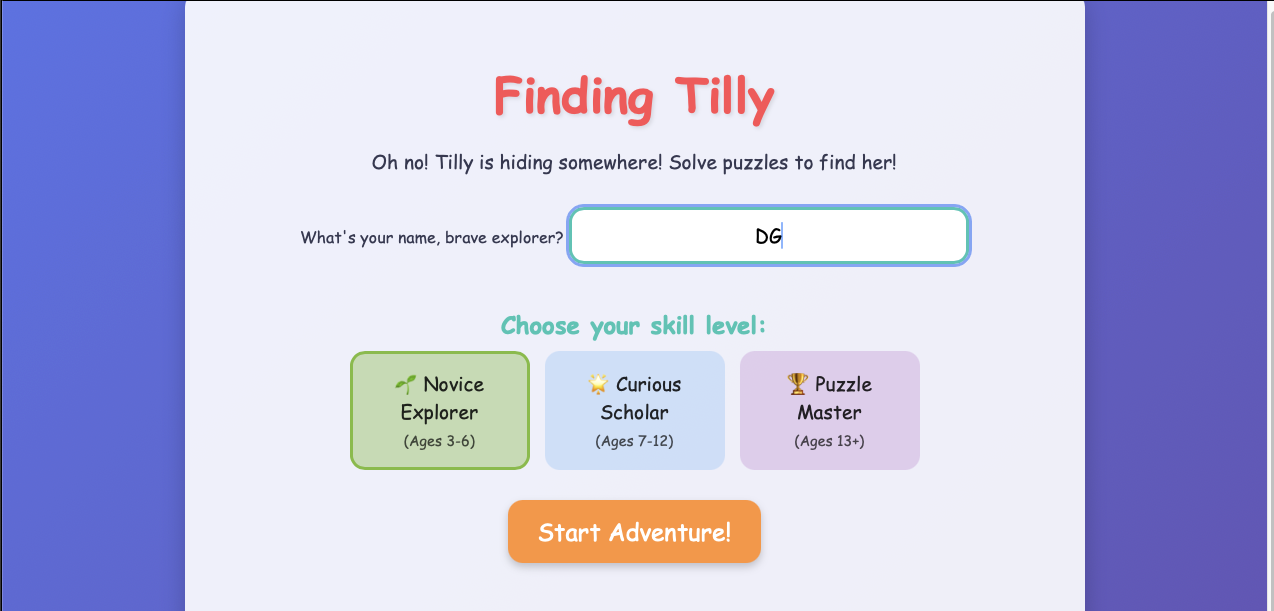 Fig 1: Login Screen
Fig 1: Login Screen
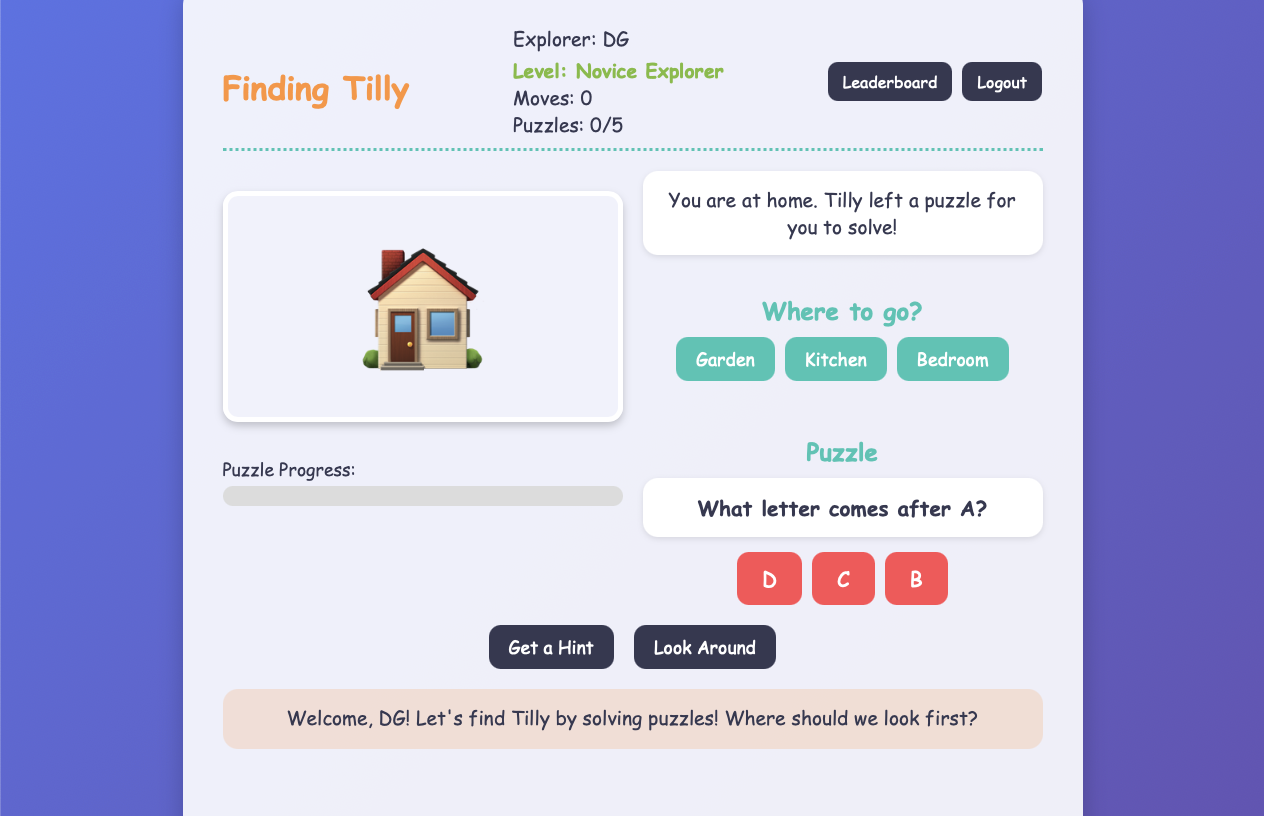 Fig 2: Puzzle Screen
Fig 2: Puzzle Screen
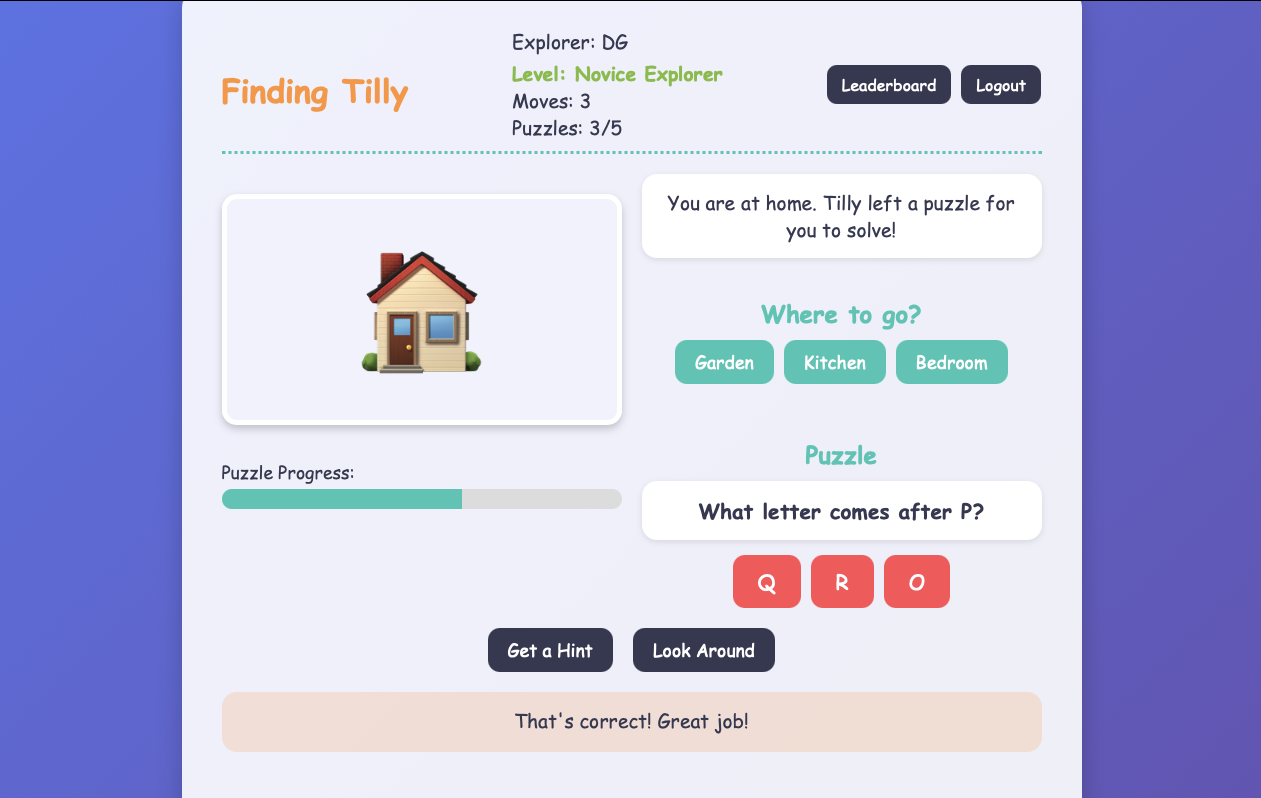 Fig 3: Game Progress
Fig 3: Game Progress
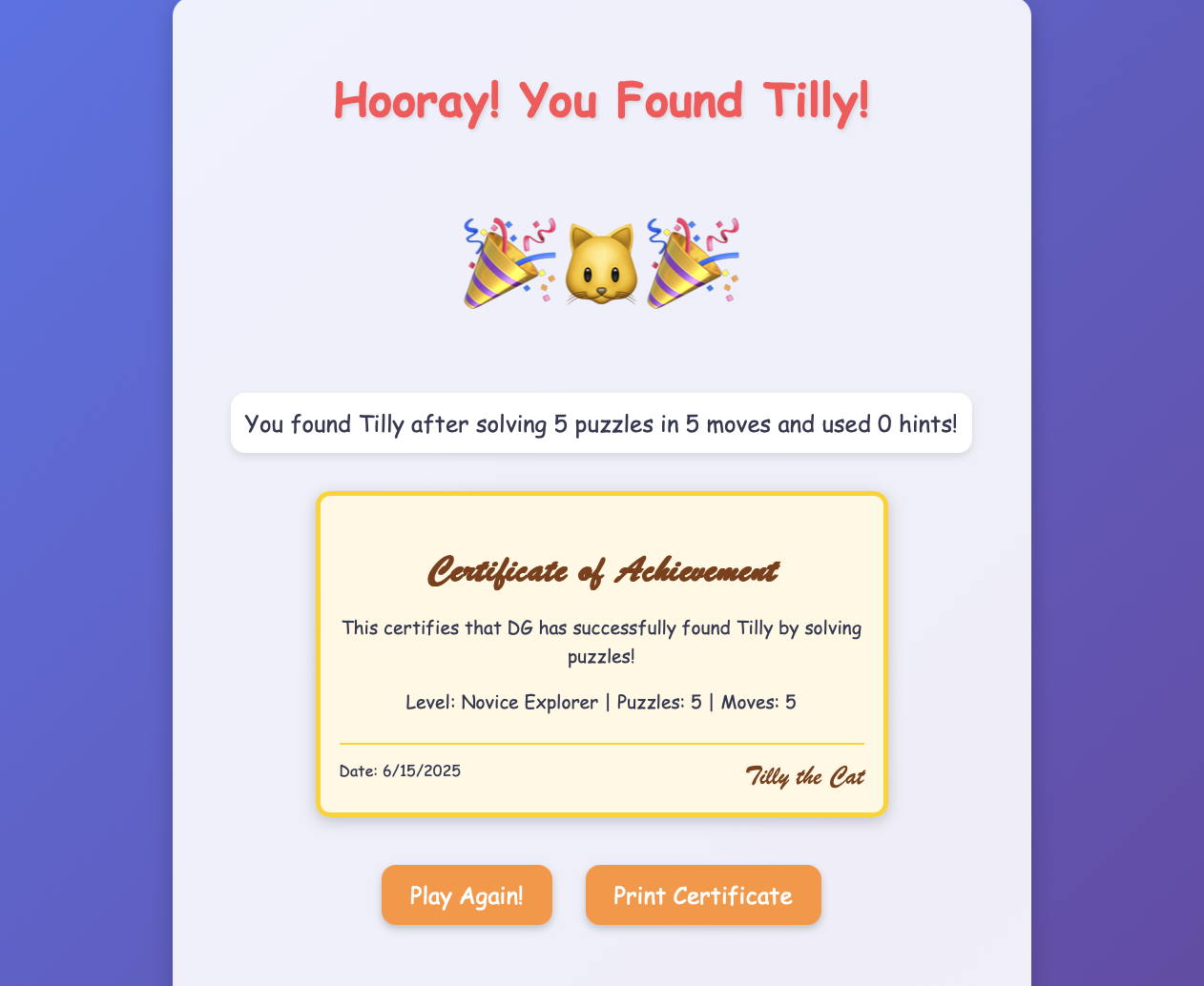 Fig 4: Puzzle Completion
Fig 4: Puzzle Completion
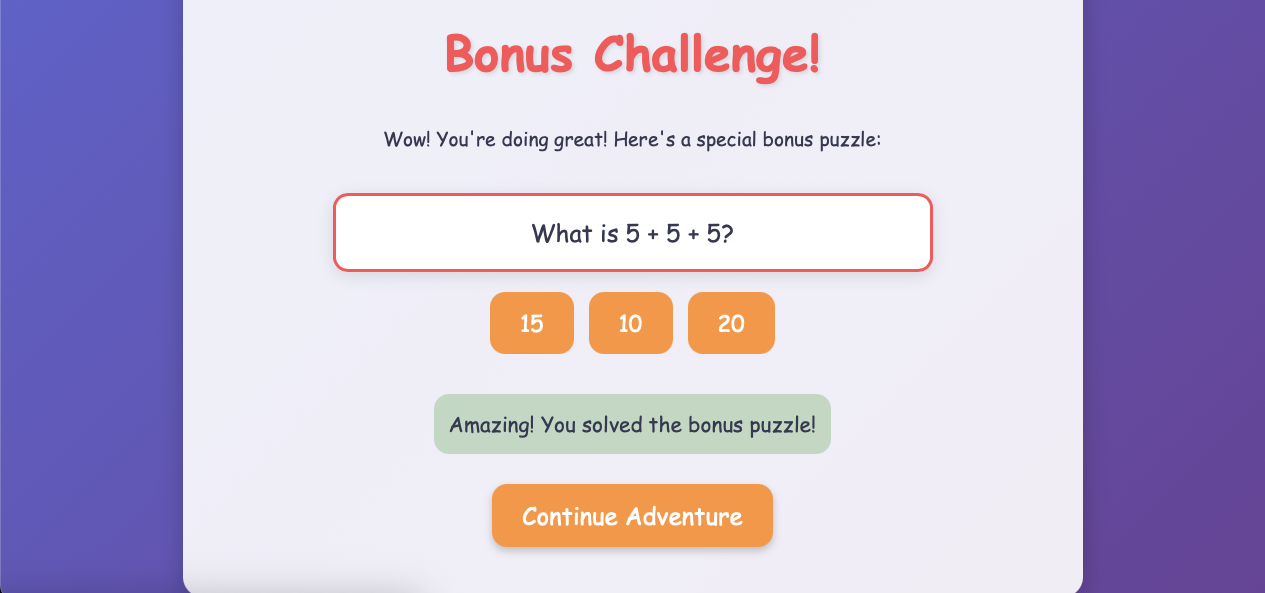 Fig 5: Bonus Round
Fig 5: Bonus Round
Next Steps
As we continue to refine the Finding Tilly educational game, our next steps include:
- Expanded Puzzle Types: Add new categories like shapes, colors, and simple words
- Adaptive Difficulty: Automatically adjust difficulty based on performance
- Parent Dashboard: Create a separate interface for parents to track progress
- Multiplayer Mode: Allow siblings or classmates to play together
- Customizable Content: Let parents or teachers add their own educational content
You can access the full code on GitHub here.
This development blog will continue to be updated as we further enhance "Finding Tilly" with additional features and refinements.
